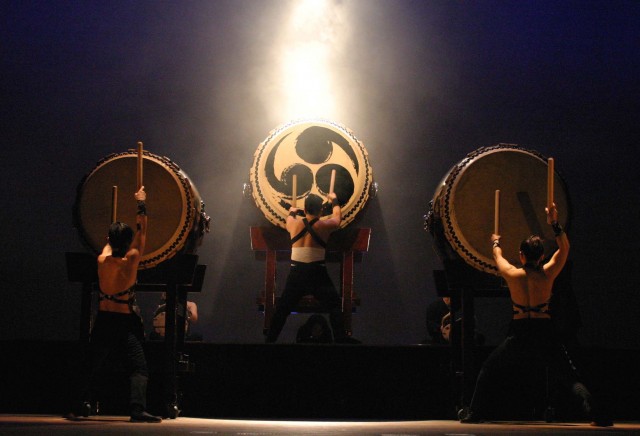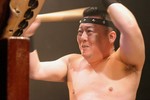ISAKU KAGEYAMA as a young taiko drummer at Bon Odori in Tokyo and an Amanojaku children’s division performance doing among other pieces “Nidanuchi.”
Thanks to all his Bon Taiko students for expressing interest. Now that they’ve gotten us started, we are thinking of editing video of his omatsuri playing.
ISAKU KAGEYAMA AS A YOUNG DRUMMER

Amanojaku taiko in “Jazz Advance”

I wrote about taiko as modern music and how Tokyo taiko legend was made by Yoichi Watanabe in this piece on Amanojaku for “Jazz Advance.”
Amanojaku concert
Amanojaku at Tokyo FM Hall
“HARU ICHIBAN (Spring Breeze)”
SUN April 18, 2010
3 p.m. (doors open 2:30 p.m.)
Taiko drumming by
Amanojaku leader/composer Yoichi Watanabe
with drummers
Hiromi Ogawa, Isaku Kageyama, Daisuke Watanabe, Hiromi Sekine, Chris Holland,
and guests
Kyosuke Suzuki on fue flutes, Katsunari Sawada on Tsugari shamisen
also
Amanojaku Hozonkai.
1-7 Kojimachi Chiyoda-ku Tokyo
TEL: 03-3221-0080
3 minute walk from exits 1 and 2 Hanzomon station on the Hanzomon Line.
6 minute walk from exits 1 and 2 Kojimachi station on the Yurakucho Line.
Advance tickets 4,000 yen
Same-day admission 4,500 yen
For tickets, please call Amaonojaku TEL: 03-3904-1745
Ticket Pia (from March 30, 2010)
Pコード:103-507 TEL:0570-02-9999
No reserved seating.
At One With Brazil
Amanojaku’s Yoichi Watanabe and Isaku Kageyama are now in Brazil to share the joy of taiko.
“Kizuna” was co-written by Watanabe and the late Daihachi Oguchi of Osuwa Daiko for the 100th anniversary of Japanese immigration to Brazil, celebrated June 21,
2008 by a performance of 1,000 Brazilian taiko drummers.
The first four minutes of the piece is trademark Oguchi, and then the song breaks into Amanojaku-style taiko that is totally and distinctly Watanabe.
Below is video of a group in Brazil performing “Kizuna” in December:
And this is the same song performed by Amanojaku and students in Japan:
Amanojaku traveled to Brazil 6 times during 2004-2008, teaching more than 600 Japanese-Brazilian youngsters.
The performance was attended by 37,000 people, including Crown Prince Naruhito.
“Kizuna” means “bond” in Japanese _ what is in our heritage and our blood that transcends boundaries and the passage of time to connect people in spirit.
Amanojaku has continued to go to Brazil to teach in 2009 _ and now in 2010.
Amanojaku at Sogetsu Hall
Amanojaku concert at Sogetsu Hall in Tokyo Dec. 8, 2009.
“Kaiun” by Yoichi Watanabe, performed by (from left to right) Daisuke Watanabe, Isaku Kageyama, Yoichi Watanabe and Hiromi Ogawa.
The Autobiography of Yoichi Watanabe 2

Isao Tokuhashi and I are working together in compiling an oral history of Yoichi Watanabe, the leader and founder of Tokyo taiko group Amanojaku.
Link to an earlier excerpt, and below another excerpt from the work-in-progress, “The Autobiography of Yoichi Watanabe _ as told to Isao Tokuhashi and Yuri Kageyama”:
Most teachers set a two hour or three hour lesson and charge for those hours.
I don’t do that. When I teach a group, I teach from morning until night. That’s because we are going toward the same dream.
Maybe this makes me unprofessional. But I want to be moved. If the people I am involved with are passionate about the music, and they are moved, then I am moved. If I am dishonest to what I believe, I think people will see that.
And so I don’t think about the hours. It’s impossible to teach or create what I want in two or three hours.
The people who perform with me often break into tears. That’s when a teacher can feel truly fulfilled. That’s what I live for.
It’s the same if I go abroad. It gets very busy when I go to Brazil. There is no rest. We are going to lessons from morning until night. But some of the kids are waiting at the hotel for us to get back because they so much want to learn.
I believe that being a taiko drummer was the best job for me. But I also believe that it was a mission given to me by the heavens.
I needed to write a page in taiko history. I wanted to pave the way for those who come after me.
I needed to be able to teach with confidence or else my students won’t be able to play with confidence.
A professional performance is not a recital for friends.
A professional must be spiritually strong like an Olympic athlete undergoing Spartan training.
But without a relationship of trust, a teacher cannot make a student go through that kind of training. If you have not endured this kind of training, and become truly professional, you will be ignored in the professional world.
It all depends on the person. Some need to be scolded. Some need to be praised. Some pick it up without your having said a word, while others never get it even if you tell them many times.
I created the original music that is Amanojaku.
I never wavered. I was always going straight after that goal.
If the roots of a tree are rotten, then it will never flower. But if the roots are solid, the stem will grow strong.
While others paint in colorful oils, I am taking a sumi brush and painting to find my own way. Once I decided that, the rest was easy
AMANOJAKU Taiko at Sogetsu Hall in Tokyo
THE BEAT OF LEGACY – Dentou no Hibiki
AMANOJAKU Taiko Concert in Tokyo
TUE Dec. 8, 2009
Sogestsu Hall
7 p.m. (doors open 6:30 p.m.)
For tickets, please email: isaku.kageyama@amanojaku.info
Featuring composer, Amanojaku leader and founder YOICHI WATANABE
with HIROMI OGAWA, ISAKU KAGEYAMA, DAISUKE WATANABE, CHRIS HOLLAND and HIROMI SEKINE; guest on fue KYOSUKE SUZUKI.
The Autobiography of Yoichi Watanabe

Yoichi Watanabe, (photo by Naokazu Oinuma) leader of Tokyo taiko group Amanojaku, is relating his life history and his thoughts on taiko to Isao Tokuhashi and me.
It is a project that has just begun. And a lot of work still awaits.
But it fascinates me for what it promises to deliver in understanding of a great artist, an important era of post-war Japanese creativity and the conceptual and spiritual backbone of modern music called taiko.
Yoichi Watanabe founded Amanojaku in 1987.
But his story _ one man’s journey in taiko _ began in the late 1960s, when he was about 10 years old.
He lived through the pioneering years of Tokyo-style taiko, playing with Sukeroku Daiko, founded in 1959 as this city’s first professional kumi-daiko troupe.
An excerpt from “The Autobiography of Yoichi Watanabe _ as told to Isao Tokuhashi and Yuri Kageyama”:
To be honest, I am not sure anyone would want to read a book about my life.
Besides, 10 years from now, my thoughts are bound to have changed, and I would need to write another book.
But I’ve always wanted to write down a certain philosophy on life that I have arrived at over the years in my own small way.
There is such a thing in life as the correct path _ a “seido.”
I am no different in having pursued what I thought was this correct path for me.
I have been doing it all my life.
I was in fourth grade when I decided I wanted to be a taiko drummer.
And I have never swerved from that path.
And it was just one path.
It was not an easy path, one filled with thorny bushes along the way.
But I have developed a way of looking at life through taiko.
And so this book is not a manual about how to play taiko.
Please look at a DVD or a read a manual textbook for that.
Everyone starts out with a dream, and then many people arrive at another way of life to make a living.
You may want to be a doctor or a pilot. But if you can’t realize that dream, you may have to settle on a more realistic job.
We are supposedly in the worst crisis in a century.
People are all working hard.
Perhaps they would be encouraged to find I have never gone far astray from my path over all these years.
I don’t have anything all that special to say.
It’s very ordinary. It’s no different from everyone else’s dreams.
If you keep yourself open, then you will realize your goal in all its depth and breadth.
That kind of spirit has been lost, this spirit I have strived to pursue all my life.
It’s human to seek the easy way, but I have stuck to the way even if it meant hardships.
If people tell me to go one way, then sometimes I question that and go counter-clockwise.
I have always been a rebel, an Amanojaku.
Taiko gigs
Photo by Ryan Bruss.
OCT. 4, 2009
AMANOJAKU concert at Kuroiso Bunka Kaikan,
490 Kami Atsu-zaki Nasu Shiobara-shi Tochigi 325-0026.
For tickets, please call 0287-63-3219.
Doors open 1 p.m. Music starts 2 p.m.
2,000 yen (1,000 yen for students).
OCT. 12, 2009
MINYO “LIVE” at Shinjuku Takanoya. 03-5919-0228.
Isaku Kageyama (taiko) with Rie Sakamoto (song), Seiemon Sawada (shamisen), Yoshinori Kikuchi (shakuhachi).
5-2-3-B1 Shinjuku Shinjuku-ku Tokyo 160-0022.
Doors open 6:30 p.m. Music starts 7 p.m.
Advance tickets 2,000 yen; at the door 2,500 yen.
For reservations, email: isaku.kageyama@amanojaku.info
OCT. 17, 2009
AMANOJAKU at DECHIKONKA, annual festival in Ehime Prefecture.
Call Kihoku city hall at 0895-45-1111.
Starts 6 p.m.
OCT. 22, 2009
THE BEAT AHEAD _ Wadaiko “live” at Harajuku Crocodile.
Featuring Isaku Kageyama and Yuu Ishizuka on taikos with Winchester Nii Tete, Chris Holland and other guests.
Call The Crocodile at 03-3499-5205.
6-18-8-B1 Jingumae Shibuya-ku Tokyo 150-0001.
Doors open 6 p.m. Music starts 7:30 p.m.
Advance tickets 3,000 yen. At door 3,500 yen.
For reservations, email: isaku.kageyama@amanojaku.info
DEC. 8, 2009
AMANOJAKU at SOGETSU HALL.
Call Sogetsu Hall at 03-3408-1154.
7-2-21 Akasaka Minato-ku Tokyo 107-8505.
Doors open 6.30 p.m. Music starts 7 p.m.
For reservations, email: isaku.kageyama@amanojaku.info
JAN 10, 2010.
AMANOJAKU Student recital TENSHONOKAI.
Kameari Lirio Hall 03-5680-2222.
Doors open 2 p.m. Music starts 2:30 p.m.
1,000 yen donation.
JAN. 15-FEB. 8
AMANOJAKU workshops in Brazil.
APRIL 18, 2010.
AMANOJAKU concert at TOKYO FM Hall.
Doors open 5:30 p.m. Music starts 6 p.m.
Tokyo FM Hall 03-3221-0080.
1-7 Kojimachi Chiyoda-ku Tokyo 102-0080.
For reservations, email: isaku.kageyama@amanojaku.info
Talking Taiko _ the Movie
Yoichi Watanabe, master taiko drummer, shows his stuff at Bon Odori _ as he does each and every year (with Daisuke Watanabe and Isaku Kageyama of Watanabe-led Amanojaku).
Bon Odori
Conneting with the past
And all that went before us
Connecting with the future
And all that awaits
A poetic moment
Being a poet is seeing so much more in the everyday.
Bon Odori is the closing scene of “Talking Taiko,” a movie I’m working on with Japanese director and film-maker Yoshiaki Tago.
He’s doing his stuff on a Shibuya pedestrian walkway _ another place where we are finding a poetic moment.
trailer on YouTube
Do we write to live or live to write?
Do we write to remember or do we write to forget?
Do we write to remember or do we write to be remembered?
Do we write so we don’t kill or do we write so we don’t kill ourselves?
Do we make movies to live or live to make movies?
Do we make music to live or live to make music?
Do we write to live or live to write?
Do we live?
Do we live?
Do we live?
